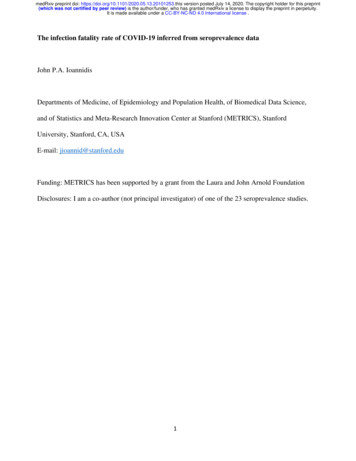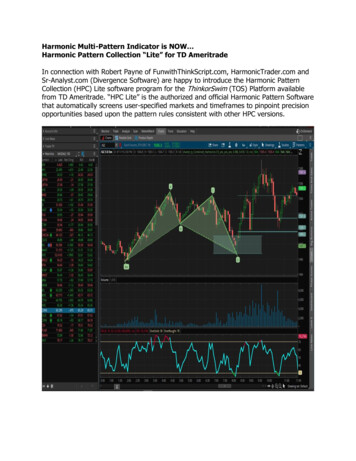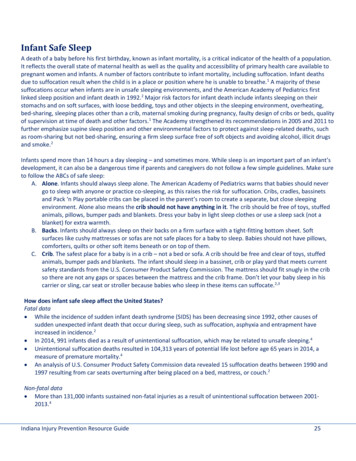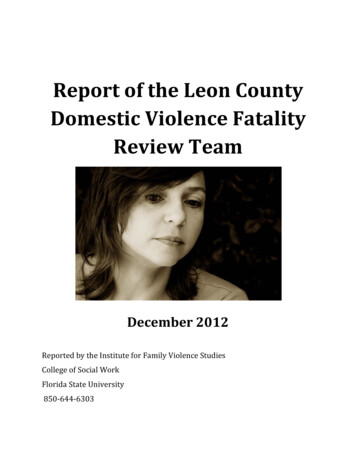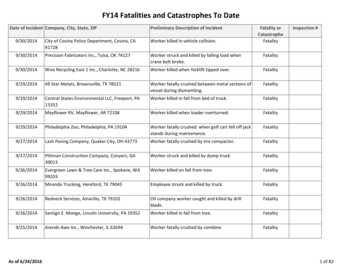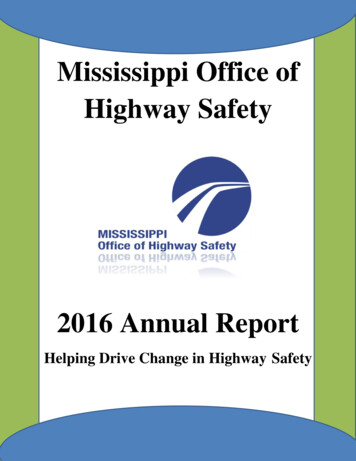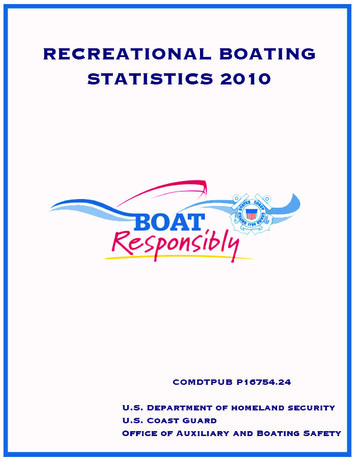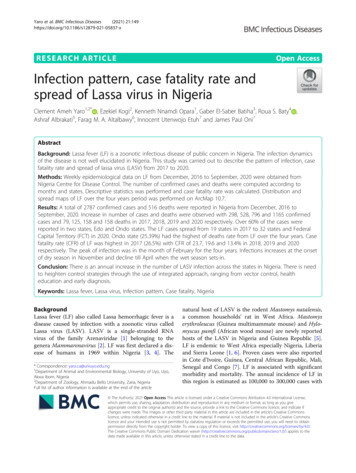
Transcription
Yaro et al. BMC Infectious Diseases(2021) SEARCH ARTICLEOpen AccessInfection pattern, case fatality rate andspread of Lassa virus in NigeriaClement Ameh Yaro1,2* , Ezekiel Kogi2, Kenneth Nnamdi Opara1, Gaber El-Saber Batiha3, Roua S. Baty4 ,Ashraf Albrakati5, Farag M. A. Altalbawy6, Innocent Utenwojo Etuh7 and James Paul Oni7AbstractBackground: Lassa fever (LF) is a zoonotic infectious disease of public concern in Nigeria. The infection dynamicsof the disease is not well elucidated in Nigeria. This study was carried out to describe the pattern of infection, casefatality rate and spread of lassa virus (LASV) from 2017 to 2020.Methods: Weekly epidemiological data on LF from December, 2016 to September, 2020 were obtained fromNigeria Centre for Disease Control. The number of confirmed cases and deaths were computed according tomonths and states. Descriptive statistics was performed and case fatality rate was calculated. Distribution andspread maps of LF over the four years period was performed on ArcMap 10.7.Results: A total of 2787 confirmed cases and 516 deaths were reported in Nigeria from December, 2016 toSeptember, 2020. Increase in number of cases and deaths were observed with 298, 528, 796 and 1165 confirmedcases and 79, 125, 158 and 158 deaths in 2017, 2018, 2019 and 2020 respectively. Over 60% of the cases werereported in two states, Edo and Ondo states. The LF cases spread from 19 states in 2017 to 32 states and FederalCapital Territory (FCT) in 2020. Ondo state (25.39%) had the highest of deaths rate from LF over the four years. Casefatality rate (CFR) of LF was highest in 2017 (26.5%) with CFR of 23.7, 19.6 and 13.4% in 2018, 2019 and 2020respectively. The peak of infection was in the month of February for the four years. Infections increases at the onsetof dry season in November and decline till April when the wet season sets-in.Conclusion: There is an annual increase in the number of LASV infection across the states in Nigeria. There is needto heighten control strategies through the use of integrated approach, ranging from vector control, healtheducation and early diagnosis.Keywords: Lassa fever, Lassa virus, Infection pattern, Case fatality, NigeriaBackgroundLassa fever (LF) also called Lassa hemorrhagic fever is adisease caused by infection with a zoonotic virus calledLassa virus (LASV). LASV is a single-stranded RNAvirus of the family Arenaviridae [1] belonging to thegenera Mammarenavirus [2]. LF was first declared a disease of humans in 1969 within Nigeria [3, 4]. The* Correspondence: yaro.ca@uniuyo.edu.ng1Department of Animal and Environmental Biology, University of Uyo, Uyo,Akwa Ibom, Nigeria2Department of Zoology, Ahmadu Bello University, Zaria, NigeriaFull list of author information is available at the end of the articlenatural host of LASV is the rodent Mastomys natalensis,a common households’ rat in West Africa. Mastomyserythroleucus (Guinea multimammate mouse) and Hylomyscus pamfi (African wood mouse) are newly reportedhosts of the LASV in Nigeria and Guinea Republic [5].LF is endemic to West Africa especially Nigeria, Liberiaand Sierra Leone [1, 6]. Proven cases were also reportedin Cote d’Ivoire, Guinea, Central African Republic, Mali,Senegal and Congo [7]. LF is associated with significantmorbidity and mortality. The annual incidence of LF inthis region is estimated as 100,000 to 300,000 cases with The Author(s). 2021 Open Access This article is licensed under a Creative Commons Attribution 4.0 International License,which permits use, sharing, adaptation, distribution and reproduction in any medium or format, as long as you giveappropriate credit to the original author(s) and the source, provide a link to the Creative Commons licence, and indicate ifchanges were made. The images or other third party material in this article are included in the article's Creative Commonslicence, unless indicated otherwise in a credit line to the material. If material is not included in the article's Creative Commonslicence and your intended use is not permitted by statutory regulation or exceeds the permitted use, you will need to obtainpermission directly from the copyright holder. To view a copy of this licence, visit http://creativecommons.org/licenses/by/4.0/.The Creative Commons Public Domain Dedication waiver ) applies to thedata made available in this article, unless otherwise stated in a credit line to the data.
Yaro et al. BMC Infectious Diseases(2021) 21:149about 5000 deaths and 58 million people at risk [8].Twenty percent of infected individuals requirehospitalization while 80% are asymptomatic infections[9]. The case fatality rate of hospitalized cases rangesfrom 15 to 20% in Africa [6].Transmission of the virus to humans occur throughdirect contact with rat’s excretions such as urine andfeces, eating of food and inhalation of contaminated dustcontaining body secretions of infected rats, as well aseating the rat [6, 7, 10, 11]. Person to person transmission occurs by direct contact with blood or bodily fluidsof infected individuals [8, 12]. It can also be transmittedthrough contact with urine and semen of infected individuals, thereby posing risk for sexual transmission. Arecent study reported presence of viral nuclei acid insemen up to 103 days after onset [13]. Infected individuals becomes contagious at the onset of symptom andincreases with disease severity [14–16]. Hospitalized patients with LF may pose a significant risk to healthcareworkers (HCWs) and to other patients due to its contagious nature [7, 8, 12]. The virus has an incubationperiod of usually 7–10 days, with a reported range of 3–21 days [6, 12, 14, 16].Symptoms include fever and malaise, pharyngitis,gastrointestinal complaints, and cough. In later stagesbleeding, facial oedema, convulsions, pericardial effusions and coma are commonly observed [7, 12, 17].Diagnosis is by blood samples which are examined usingLASV specific real time reverse-transcriptase polymerasechain reaction (RT-PCR) [18]. The major control strategy is the control of the rodents around dwellings,avoiding of rats consumption and contact [6]. Currently,there are no vaccines against LASV. Although, off-labeltreatment consider the use of ribavirin [9], an expensivetreatment that is effective when administered for thefirst six days after the onset of symptoms [19].In Nigeria, the Federal Ministry of Health (FMoH)through the Nigeria Centre for Disease Control (NCDC)established a number of LF case management centres,often called treatment centres to operate in associationwith specialist teaching hospitals in endemic states. Despite the dangerous nature of this disease, there is scantyinformation on the seasonal pattern of infections anddistribution of LF in Nigeria. This study was carried outto describe the pattern of infection, distribution, spreadand case fatality rate of LF in Nigeria over the last fouryears. The results of this study will provide informationfor relevant authorities in the design of appropriatestrategies and intervention in the control of this virus.MethodsStudy areaNigeria is located on the western coast of Africa. It has adiverse geography with climates ranging from arid toPage 2 of 9humid equatorial with two distinct seasons (wet season– May to October and dry season – November to April)[20]. Nigeria has a population of over 200 million [21]with a total land area of 923,769 km2. The country has36 states and a Federal Capital Territory (FCT) with 774Local Government Areas (LGAs) [22].LF surveillance in NigeriaLF surveillance in Nigeria is conducted through the Integrated Disease Surveillance and Response (IDSR) platform. Information on LF flows from the health facilities,through the ward focal persons to the Local GovernmentArea (LGA) Disease Surveillance and Notification Officers (DSNOs), to the State DSNOs, to the State Epidemiologist and then to the NCDC, FMoH. All states inNigeria including FCT report through the IDSR [22].Weekly reports on number of confirmed cases anddeaths from LF are published in the LF weekly epidemiological reports by the NCDC.Source of dataEpidemiological data on LF from December 2016 to September, 2020 were obtained from NCDC weekly reports[23] (Additional file 1).Statistical analysisThe data on confirmed cases and confirmed deaths werecomputed into Microsoft Excel (version 2012; MicrosoftCorp., Redmond, USA) according to states and epidemiological weeks. The data obtained were subjected todescriptive statistics. Monthly and annual confirmedcases and deaths of LF was calculated according tostates. Case fatality rate (CFR) was calculated using theformula below.Case Fatality Rate ðCFRÞ ¼Number of Deathsx 100Number of CasesAnalysis was performed using the Statistical Packagefor Social Sciences (SPSS) software (version 22.0 for windows; SPSS Inc., Chicago, IL, USA). Distribution Mapwas carried out on ArcMap (version 10.7 for windows;Redland, CA: Environmental Systems ResearchInstitute).ResultsDistribution of confirmed casesAn assessment of the weekly reports on LASV infectionin Nigeria over the last four years is reported in thisstudy. The result from this study revealed a gradual increase in the number of confirmed cases of LASV. Sincethe outbreak of LASV in December 2016, Nigeria havereported 2787 confirmed cases of this virus. A total of298 confirmed cases were observed in 2017 since the
Yaro et al. BMC Infectious Diseases(2021) 21:149Page 3 of 9outbreak of the disease in December, 2016. In 2018, a totalof 528 cases were confirmed, this number almost doubledthe number of confirmed cases recorded in 2017 (Table 1).Similar observation were recorded in 2019 and 2020 withconfirmed cases of 796 and 1165 respectively.Majority of the confirmed cases were reported fromtwo states of the federation namely Edo and Ondostates. These two states accounted for 60, 67, 70 and67% of confirmed cases in 2017, 2018, 2019 and 2020 respectively. Edo and Ondo states reported 37.58% (112Table 1 Percent Number of Confirmed Cases of LASV in NigeriaStatesTotal Number of Confirmed Cases20172018Total20192020Abia–1 (0.19)1 (0.13)6 (0.52)8 (0.29)Adamawa–3 (0.57)1 (0.13)7 (0.60)11 (0.39)Akwa Ibom–––––Anambra1 (0.34)6 (1.14)–2 (0.17)9 (0.32)Bauchi11 (3.69)23 (4.36)55 (6.91)45 (3.86)134 (4.81)Bayelsa–––––Benue–1 (0.19)8 (1.01)9 (0.77)18 (0.65)Borno1 (0.34)––5 (0.43)6 (0.22)Cross River2 (0.67)–1 (0.13)1 (0.09)4 (0.14)Delta–7 (1.33)2 (0.25)16 (1.37)25 (0.90)Ebonyi5 (1.68)61 (11.55)53 (6.66)82 (7.04)201 (7.21)Edo112 (37.58)218 (41.29)289 (36.31)386 (33.13)1005 (36.06)Ekiti–2 (0.38)––2 (0.07)Enugu1 (0.34)1 (0.19)2 (0.25)10 (0.86)14 (0.50)FCT–5 (0.95)3 (0.38)3 (0.26)11 (0.39)Gombe1 (0.34)4 (0.76)4 (0.50)11 (0.94)20 (0.72)Imo–5 (0.95)1 (0.13)–6 (0.22)Jigawa–––––Kaduna4 (1.34)1 (0.19)3 (0.38)7 (0.60)15 (0.54)Kano7 (2.35)1 (0.19)–7 (0.60)15 (0.54)Katsina–––6 (0.52)6 (0.22)Kebbi––7 (0.88)4 (0.34)11 (0.39)Kogi2 (0.67)7 (1.33)4 (0.50)37 (3.18)50 (1.79)Kwara2 (0.67)–2 (0.25)–4 (0.14)Lagos11 (3.69)1 (0.19)–1 (0.09)13 (0.47)Nasarawa15 (5.03)5 (0.95)6 (0.75)9 (0.77)35 (1.26)Niger–––––Ogun7 (2.35)––2 (0.17)9 (0.32)Ondo69 (23.15)138 (26.14)273 (34.30)399 (34.25)879 (31.54)Osun–2 (0.38)–2 (0.17)4 (0.14)Oyo––2 (0.25)1 (0.09)3 (0.11)Plateau21 (7.05)15 (2.84)35 (4.40)34 (2.92)105 (3.77)Rivers2 (0.67)1 (0.19)3 (0.38)9 (0.77)15 (0.54)Sokoto–––6 (0.52)6 (0.22)Taraba24 (8.05)20 (3.79)40 (5.03)58 (4.98)142 (5.10)Yobe–––––Zamfara––1 (0.13)–1 (0.04)Total29852879611652787
Yaro et al. BMC Infectious Diseases(2021) 21:149people) and 23.15% (69 people) in 2017, 41.29% (218people) and 26.14% (138 people) in 2018, 36.31% (289people) and 34.30% (273 people) in 2019, and 33.13%(386 people) and 34.25% (399 people) in 2020 respectively making these two states the epicenter of LASV inNigeria (Fig. 1). Increasing number of confirmed caseswas observed in these states with year. Edo state is located in the South-South Region and Ondo state in theSouth-West Region of Nigeria. Consistent cases of LASVwere reported from these two states throughout the year.Other states with high cases are Taraba, Plateau, Bauchiand Ebonyi states.Cumulative confirmed cases for each state over thelast four years revealed that Edo state had the highestconfirmed cases of 36.06% followed by Ondo state with31.54%. Other states such as Ebonyi, Taraba, Bauchi andPlateau had appreciable number of confirmed cases of7.21, 5.10, 4.81 and 3.77% respectively (Table 1). The result revealed increase in number of confirmed casesacross many states of the country.Spread of LASVIn 2017, 19 states reported LF cases which furtherspread to 26 states and the FCT in 2018, 30 states andthe FCT in 2019 and to 32 states and the FCT in 2020(Fig. 2). By September 2020, LASV was reported in 32states of Nigeria over the last four years (Table 1, Fig. 2).In this study, states previously not endemic for LASVbut now have new confirmed cases reported by thePage 4 of 9NCDC were considered as new geographical spread forthe virus.Distribution of confirmed deathA total of 516 confirmed death were reported from LFinfection in Nigeria over the last four years; 2017–2020.There was an increase in death rate from 79 in 2017 to156 in 2020.Death from LF occurred in 15 states in 2017. In 2017,majority of the deaths occurred in Edo state accountingfor 17(21.52%) of the death in that year, followed byTaraba and Ondo states with 15.19% (12 people) and13.92% (11 people) respectively. In 2018, Ondo state hadthe highest number of confirmed deaths 25(20.0%) fromLF, followed by 24(19.20%) in Edo, 23(18.40%) in Ebonyiand 12(9.60%) in Bauchi states. In 2019, Ondo state stillmaintain the highest death from LF with 45(28.85%)deaths and was closely followed by Edo state with44(28.21%) while Ebonyi had 17(10.90%) deaths. In 2020,Ondo state still had the highest death rate from LF with50(32.05%), followed by Edo and Taraba states with21(13.46%) and 19(12.18%) respectively (Table 2).The cumulative death over the four years period revealed that Ondo state had the highest number of deathsfrom LF with 131(25.39%), followed by Edo state with106(20.54%), Ebonyi state with 54(10.47%) (Table 2). Atotal of 30 states in the country have reported deathsfrom LF over the four period.Fig. 1 Distribution of Confirmed cases of LASV Infection in Nigeria from 2017 – September, 2020
Yaro et al. BMC Infectious Diseases(2021) 21:149Page 5 of 9Fig. 2 Map of the Geographical Spread of Reported Cases of LF in NigeriaCase fatality rateThe case fatality rate (CFR) from LF in Nigeria was highest at the onset of the outbreak in 2017 with a fatalityrate of 26.5%. It decreased little in 2018 to 23.7% andfurther decrease to 19.6 and 13.4% in 2019 and 2020 respectively (Table 3). The cumulative CFR over the lastfour years stood at 18.5%. There is fluctuation in theCFR across the states.Pattern of infectionsThe monthly cases of LASV infection over the four yearsrevealed significant difference (p 0.05) across themonths of the year. Higher infections and deaths occurred during the dry months than the wet months(Fig. 3). Increase in infections was observed at the onsetof the dry season in November and progressively increases in December, January, peaking in February afterwhich it began to decrease until May when the wet season sets in. Highest cases of LASV infection occurred inthe month February in the four years of observation.The trend given above was observed throughout the fouryears (Fig. 3 and Fig. 4).DiscussionThis study have shown that there is progressive increasein LASV infection in Nigeria, since the outbreak wasfirst reported. The infection exhibited seasonal variability, with the dry season having a significantly higher infection rate than the wet season. The peak infection ratewas recorded in February. Similar observation has beenreported at Irrua, Edo State [18]. Zhao et al. [24] in theirstudy observed that the major LF epidemic in Nigeriausually occur between November and May during thedry season. A study in Guinea [25] reported that high indoor populations of M. natalensis during the dry seasonthan the wet season might have contributed to thehigher outbreaks of LASV during the dry season. M.natalensis plays a significant role in the rodent to humantransmission of the LASV, its high abundance in humandwelling has a direct impact on prevalence. Also, thehigh reproductive ability of M. natalensis is another contributing factor in the spread of the LASV as the rodentscan recover its populations within a few months [26].Human activities such as bush burning which is usuallycarried out during the dry seasons in the Forest andGuinea Savannah regions of Nigeria where rodents arehunted for meats is another factor favouring the higherprevalence of LASV during the dry season. This activitydestroys the rodents’ habitats and thereby encouragingtheir movement from bushes to human dwellings insearch of shelter and food [27–29].Recently, the LASV has been reported in other rodenthosts other than M. natalensis. These new LASV reservoirs are the Mastomys erythroleucus (Guinea multimammate mouse) found in Nigeria and Guinea, andHylomyscus pamfi (African wood mouse) in Nigeria [5].The current presence of LASV in these hosts provideshigh chances of transmission and resurgence of the virus
Yaro et al. BMC Infectious Diseases(2021) 21:149Page 6 of 9Table 2 Percent Number of Confirmed Deaths from LF inNigeriaStatesTotal Number of Confirmed DeathTable 3 Case Fatality Rate (CFR) of LF in NigeriaStatesTotalCase Fatality 100.033.350.0Abia–1 (0.80)1 (0.64)2 (1.28)4 (0.78)Adamawa66.7100.014.336.4Adamawa–2 (1.60)1 (0.64)1 (0.64)4 (0.78)Akwa IbomAkwa Ibom –––––AnambraAnambra1 (1.27)1 (0.80)–1 (0.64)3 (0.58)BauchiBauchi7 (8.86)12 (9.60)8 (5.13)9 (5.77)36 (6.98)BayelsaBayelsa–––––BenueBenue–1 (0.80)5 (3.21)3 (1.92)9 (1.74)BornoBorno–––1 (0.64)1 (0.19)Cross RiverCross River2 (2.53)–1 (0.64)–3 (0.58)Delta37.532.0Delta–2 (1.60)–6 (3.85)8 (1.55)Ebonyi20.037.732.115.926.9Ebonyi1 (1.27)23 (18.40) 17 (10.90) 13 (8.33)54 (10.47)Edo15.211.015.25.4Edo17 (21.52) 24 (19.20) 44 (28.21) 21 (13.46) 106 (20.54)Ekiti50.0Ekiti–1 (0.80)––1 (0.19)Enugu100.050.020.028.6Enugu–1 (0.80)1 (0.64)2 (1.28)4 (0.78)FCT60.066.766.763.6FCT–3 (2.40)2 (1.28)2 (1.28)7 (1.36)Gombe100.0100.025.09.135.0Gombe1 (1.27)4 (3.20)1 (0.64)1 (0.64)7 �–Kaduna50.0100.028.633.3Kaduna2 (2.53)1 (0.80)–2 (1.28)5 (0.97)Kano71.414.340.0Kano5 (6.33)––1 (0.64)6 (1.16)Katsina33.333.3Katsina–––2 (1.28)2 (0.39)Kebbi14.325.018.2Kebbi––1 (0.64)1 (0.64)2 (0.39)Kogi75.013.526.0Kogi1 (1.27)4 (3.20)3 (1.92)5 (3.21)13 (2.52)KwaraKwara–––––Lagos27.3Lagos3 (3.80)–––3 (0.58)Nasarawa40.0Nasarawa6 (7.59)3 (2.40)4 (2.56)4 (2.56)17 (3.29)NigerNiger–––––Ogun28.6Ogun2 (2.53)–––2 (0.39)Ondo15.9Ondo11 (13.92) 25 (20.00) 45 (28.85) 50 (32.05) 131 (25.39)OsunOsun–1 (0.80)––1 (0.19)OyoOyo––1 (0.64)1 (0.64)2 (0.39)PlateauPlateau8 (10.13)9 (7.20)10 (6.41)5 (3.21)32 (6.20)RiversRivers–1 (0.80)2 (1.28)3 (1.92)6 (1.16)SokotoSokoto–––1 (0.64)1 (0.19)TarabaTaraba12 (15.19) 6 (4.80)8 (5.13)19 (12.18) 45 (8.72)YobeYobe–––––ZamfaraZamfara––1 (0.64)–1 (0.19)TotalTotal79125156156516from time to time. These hosts are found within thesame locality with M. natalensis, thereby aiding the horizontal transmission of LASV i.e. animal to animal transmission [30]. Some studies reported increase in 13.418.5territorial habitats of M. erythroleucus which is normallya savanna mouse species found in the northern and central part of Nigeria to new localities in southern Nigeriaespecially in degraded forests [31, 32]. This might explain the current expansion in the geographical spread
Yaro et al. BMC Infectious Diseases(2021) 21:149Page 7 of 9Fig. 3 Monthly Distribution of LF (a) Confirmed Cases (b) Confirmed Deathsof LASV across the southern states of the country. In2017, Olayemi et al. [33] reported the endemicity ofLASV in 13 states. In this study, the LASV has reportedin 32 states and the FCT as at September, 2020. An evidence that the virus geographical coverage is on the increase. Olayemi et al. [33] further reported that thehosts of LASV i.e. M. natalensis, M. erythroleucus andH. pamfi were distributed across both endemic and nonendemic zones of LF. The presence of these rodents inthose communities pose potential risk of spread ofLASV.This study observed that three states in Nigeria; Edo,Ondo and Ebonyi are epicentres for LASV infections.This observation corresponds with earlier reports ofNCDC [34] and Usuwa et al. [35]. Series of factors arefavouring the increase and spread of LASV infectionsacross Nigeria; the exponential growth of humanpopulation, household size, bush burning and urbanisation are some predisposing factors [29]. In Nigeria, thepractice of drying agricultural products under the sunespecially along roadsides encourages food contamination with urine and faeces of these rodents and henceaiding transmission of LASV [35, 36]. These factors increase human vector contacts thereby putting man athigh risk of contracting zoonotic pathogens [37].ConclusionThis study revealed yearly increase in the number of infected individuals with LASV. The highest monthly infection from LASV was reported in February for thefour years period. Edo and Ondo states still remain theepicenter for the virus, accounting for over 60% of annual cases. The LASV is currently endemic in 32 statesand FCT with and annual CFR of 18.5%. Therefore,
Yaro et al. BMC Infectious Diseases(2021) 21:149Page 8 of 9Fig. 4 Monthly Number of Confirmed Cases and Deaths of LF Over Four Years Periodthere is urgent need to declare an emergency against thisvirus by adopting integrated approach in its controlwhich should involve proper surveillance, health education, proper hosts’ identification, vector control, properdiagnosis, morbidity and adequate training of frontlinehealth professionals.Supplementary InformationThe online version contains supplementary material available at nal file 1.AbbreviationsLF: Lassa fever; LASV: Lassa virus; HCWs: Healthcare workers; RT-PCR: Reversetranscriptase polymerase chain reaction; NCDC: Nigeria Centre for Disease;FMoH: Federal Ministry of Health; FCT: Federal Capital Territory; LGAs: LocalGovernment Areas (LGAs); LGA: Local Government Area; IDSR: IntegratedDisease Surveillance and Response; DSNOs: Disease Surveillance andNotification Officers; CFR: Case fatality rateAcknowledgementsThe authors extend their appreciation to the researchers supporting projectnumber (TURSP-2020/269), Taif University, Taif, Saudi Arabia.Consent to participateNot applicable.Conflict of interestThe authors declare no conflict of interest.Authors’ contributionsConceptualization, C.A.Y.; methodology, C.A.Y., E.K. and K.N.O.; formal analysis,C.A.Y., I.U.E and J.P.O.; investigation, C.A.Y., E.K., K.N.O., R.S.B., A.A., F.M.A.A. andG.E.-S.B.; writing original draft, C.A.Y.; resources, C.A.Y., R.S.B., A.A., F.M.A.A. andG.E.-S.B.; review and editing, C.A.Y., E.K., K.N.O., R.S.B., A.A., F.M.A.A. and G.E.S.B. The author(s) read and approved the final manuscript.FundingThis research received no external funding.Availability of data and materialsThe data sets in this study are available from the corresponding author onreasonable request.Ethics approval and consent to participateNot applicable.Consent for publicationNot applicable.Competing interestsThe authors declare that they have no competing interests.Author details1Department of Animal and Environmental Biology, University of Uyo, Uyo,Akwa Ibom, Nigeria. 2Department of Zoology, Ahmadu Bello University, Zaria,Nigeria. 3Department of Pharmacology and Therapeutics, Faculty ofVeterinary Medicine, Damanhour University, Damanhour, AlBeheira 22511,Egypt. 4Department of Biotechnology, College of Science, Taif University, P.O.Box 11099, Taif 21944, Saudi Arabia. 5Department of Human Anatomy,College of Medicine, Taif University, P.O. Box 11099, Taif 21944, Saudi Arabia.6National Institute of Laser Enhanced Sciences (NILES), Cairo University, Giza12613, Egypt. 7Department of Animal and Environmental Biology, Kogi StateUniversity, Anyigba, Nigeria.
Yaro et al. BMC Infectious Diseases(2021) 21:149Page 9 of 9Received: 4 November 2020 Accepted: 22 January 202120. Britannica. Nigeria. Britannica; 2020. https://www.britannica.com/place/Nigeria. Retrieved 31st October, 2020.21. World Population Review (WPR). Nigeria population review (Live). WorldPopulation Review; 2020. a-population. Retrieved 31st October, 2020.22. Okoro OA, Bamigboye E, Dan-Nwafor C, Umeokonkwo C, Ilori E, Yashe R,Balogun M, Nguku P, Ihekweazu C. Descriptive epidemiology of Lassa feverin Nigeria, 2012–2017. Pan Afri Med J 2020;37(15):1–7. .37.15.2116023. Nigeria Center for Disease Control (NCDC). An update of Lassa feveroutbreak in Nigeria. Nigeria Centre for Disease Control; 2020. https://ncdc.gov.ng/diseases/sitreps/?cat 5&name 0Nigeria. 4th October, 2020.24. Zhao S, Musa SS, Fu H, He D, Qin J. Large-scale Lassa fever outbreaks inNigeria: quantifying the association between disease reproduction numberand local rainfall. Epidemiol Infect. 2020;148e4:1–12. 9002267.25. Fichet-Calvet E, Lecompte E, Koivogui L, Soropogui B, Dore A, Kourouma F, SyllaO, Daffis S, Koulemou K, ter Meulen J. Fluctuation of abundance and Lassa virusprevalence in Mastomys natalensis in Guinea, West Africa. Vector Borne ZoonoticDis 2007;7:119–128. 520.26. Mari-Saez A, Cherif HM, Camara A, Kourouma F, Sage M, Magassouba N,Fichet-Calvet E. Rodent control to fight Lassa fever: evaluation and lessonslearned from a 4-year study in upper Guinea. PLoS Negl Trop Dis 2018.12:e0006829. td.0006829.27. Adetola OO, Adebisi MA. Impacts of deforestation on the spread ofMastomys natalensis in Nigeria. World Sci News. 2019;130:286–96.28. Chapagain T, Raizada MN. Agronomic challenges and opportunities forsmallholder terrace agriculture in developing countries. Front Plant Sci 2017;8: 331. 00331.29. Abdullahi IN, Anka AU, Ghamba PE, Onukegbe NB, Amadu DO, Salami, MO.Need for preventive and control measures for Lassa fever through the onehealth strategic approach. Proceedings of Singapore Healthcare 2020;29(3):190–194. 932616.30. Adesina AS, Oyeyiola A, Gunther S, Fichet-Calvet E, Olayemi A. Phylogeneticanalysis and prevalence of Lassa virus in multimammate mice within thehighly endemic Edo-Ondo hotspot for Lassa fever, Nigeria. Proceedings of the6th International Conference of Rodent Biology and Management & 16thRodens et Spatium. 2018;p.121. 1703/Julius%20K%C3%BChn-Archiv%20459. Retrieved 31st October, 2020.31. Olayemi A, Oyeyiola A, Obadare A, Igbokwe J, Adesina AS, Onwe F, UkwajaKN, Ajayi NA, Rieger T, Gunther S, et al. Widespread arenavirus occurrenceand seroprevalence in small mammals. Nigeria Parasit Vectors. -2991-5.32. Igbokwe J, Awodiran MO, Oladejo OS, Olayemi A, Awopetu JI. Chromosomalanalysis of small mammals from southwestern Nigeria. Mamm Res 2016;61:153–159. -0254-9.33. Olayemi A, Obadare A, Oyeyiola A, Fasogbon S, Igbokwe J, Igbahenah F,Ortsega D, Gunther S, Verheven E, Fichet-Calvet E. Small mammal diversity anddynamics within Nigeria, with emphasis on reservoirs of the Lassa virus. SystBiodivers. 2017;16(2):118–27 https://doi.org/10.1080/14772000.2017.1358220.34. Nigeria Center for Disease Control (NCDC). Press Release: NCDC ReviewsLassa Fever outbreak response amidst reducing number of cases. NigeriaCenter for Disease Control; 2019. ngnumber-of-cases. Retrieved 31st October, 2020.35. Usuwa IS, Akpa CO, Umeokonkwo CD, Umoke M, Oguanuo CS, OlorukoobaAA, Bamigboye E, Balogun MS. Knowledge and risk perception towardsLassa fever infection among residents of affected communities in Ebonyistate, Nigeria: implications for risk communication. BMC Public Health 2020;20:217. -8299-3.36. Adefisan AK. The level of awareness that rat is a vector of Lassa feveramong the rural people in Ijebu north local government, Ogun state,Nigeria. J Educ Pract. 2014;5(37):166–70.37. Taylor LH, Latham SM, Woolhouse MEJ. Risk factors for human diseaseemergence. Philos Trans R Soc B: Biol Sci. 2001;356:983–9 nces1. Yun NE, Walker DH. Pathogenesis of Lassa fever. Viruses. 4102031.2. Radoshitzky SR, Buchmeier MJ, Charrel RN, Clegg JCS, Gonzalez J-PJ,Gunther S, Hepojoki J, Kuhn JH, Lukashevich IS, Romanowski V, Salvato MS,Sironi M, Steglein MD, de la Torre JC, ICTV report consortium. ICTV virustaxonomy profile: Arenaviridae. J Gen Virol 2019;100:1200–1201. 80.3. Frame JD, Baldwin JMJ, Gocke DJ, Troup JM. Lassa fever, a new virus diseaseof man from West Africa. Am J Trop Med Hyg. 1970;19: 670–676. .19.670.4. Olayemi A, Fichet-Calvet E. Systematics, ecology, and host switching:attributes affecting emergence of the Lassa virus
[20]. Nigeria has a population of over 200 million [21] with a total land area of 923,769km2. The country has 36 states and a Federal Capital Territory (FCT) with 774 Local Government Areas (LGAs) [22]. LF surveillance in Nigeria LF surveillance in Nigeria is conducted through the Inte-grated Disease Surveillance and Response (IDSR) plat-form.

